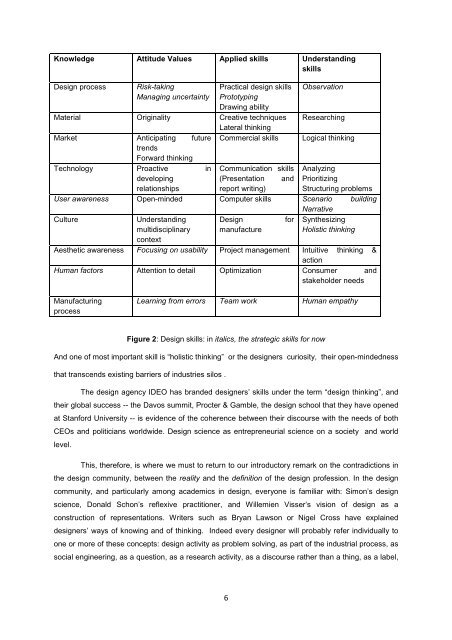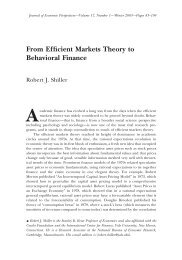Design Management as core competency
Design Management as core competency
Design Management as core competency
You also want an ePaper? Increase the reach of your titles
YUMPU automatically turns print PDFs into web optimized ePapers that Google loves.
Knowledge Attitude Values Applied skills Understanding<br />
skills<br />
<strong>Design</strong> process<br />
Risk-taking<br />
Managing uncertainty<br />
Practical design skills<br />
Prototyping<br />
Drawing ability<br />
Observation<br />
Material Originality Creative techniques Researching<br />
Lateral thinking<br />
Market Anticipating future Commercial skills Logical thinking<br />
trends<br />
Forward thinking<br />
Technology Proactive in Communication skills Analyzing<br />
developing<br />
(Presentation and Prioritizing<br />
relationships<br />
report writing) Structuring problems<br />
User awareness Open-minded Computer skills Scenario building<br />
Narrative<br />
Culture<br />
Understanding <strong>Design</strong><br />
for Synthesizing<br />
multidisciplinary manufacture<br />
Holistic thinking<br />
context<br />
Aesthetic awareness Focusing on usability Project management Intuitive thinking &<br />
action<br />
Human factors Attention to detail Optimization Consumer and<br />
stakeholder needs<br />
Manufacturing<br />
process<br />
Learning from errors Team work Human empathy<br />
Figure 2: <strong>Design</strong> skills: in italics, the strategic skills for now<br />
And one of most important skill is “holistic thinking” or the designers curiosity, their open-mindedness<br />
that transcends existing barriers of industries silos .<br />
The design agency IDEO h<strong>as</strong> branded designers’ skills under the term “design thinking”, and<br />
their global success -- the Davos summit, Procter & Gamble, the design school that they have opened<br />
at Stanford University -- is evidence of the coherence between their discourse with the needs of both<br />
CEOs and politicians worldwide. <strong>Design</strong> science <strong>as</strong> entrepreneurial science on a society and world<br />
level.<br />
This, therefore, is where we must to return to our introductory remark on the contradictions in<br />
the design community, between the reality and the definition of the design profession. In the design<br />
community, and particularly among academics in design, everyone is familiar with: Simon’s design<br />
science, Donald Schon’s reflexive practitioner, and Willemien Visser’s vision of design <strong>as</strong> a<br />
construction of representations. Writers such <strong>as</strong> Bryan Lawson or Nigel Cross have explained<br />
designers’ ways of knowing and of thinking. Indeed every designer will probably refer individually to<br />
one or more of these concepts: design activity <strong>as</strong> problem solving, <strong>as</strong> part of the industrial process, <strong>as</strong><br />
social engineering, <strong>as</strong> a question, <strong>as</strong> a research activity, <strong>as</strong> a discourse rather than a thing, <strong>as</strong> a label,<br />
6
















